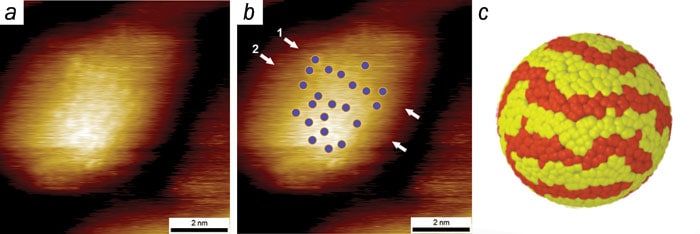Taken from the June 2014 issue of Physics World
Ten years on from a study that first reported the existence of "stripy nanoparticles", a row over the research shows no sign of ending, as Jon Cartwright reports

It started innocuously enough with a 2004 study showing that nanoparticles grown in the presence of certain molecules develop stripe-like structures on their surfaces. In recent years, however, “stripy nanoparticles” have become one of the most controversial areas in nanoscience, so much so that the debate over their existence has given rise to allegations of “cyber bullying” (see below). Now the publication of a new critique on the existence of stripes threatens to fire up the debate once more.
The story of stripy nanoparticles began in 2004, when materials scientist Francesco Stellacci, who was then at the Massachusetts Institute of Technology in Cambridge, US, and colleagues investigated the growth of gold nanoparticles in the presence of ligands – molecules that bond to metal atoms. Nanoparticles are often grown in the presence of ligands, because they act to stabilize the nanoparticles and hence prevent them from getting too big. Stellacci and colleagues claimed that when they used a mixture of two types of ligand – octanethiol and mercaptopropionic acid – for the process, the ligands organized themselves into stripes as thin as 5 Å on the nanoparticles’ surfaces.
Their principal evidence came from using scanning tunnelling microscopy (STM). In this technique, a fine, electrically conducting tip is passed over a surface, which releases electrons to quantum-mechanically tunnel upwards. By recording the subtle changes in current that ensue through the tip, scientists can reconstruct the structure of the surface. In their STM reconstructions, Stellacci’s group found that the bright circles of their nanoparticles were covered with fuzzy stripes (Nature Materials 3 330).
In the same paper, the researchers claimed that the stripy nanoparticles could repel proteins, a property that could be important for certain types of drug delivery. And in the following years Stellacci, working in conjunction with other research groups, has reported various other findings related to the nanoparticles, such as their apparent ability to penetrate biological cell membranes spontaneously. To date, stripy nanoparticles have been the subject of more than 25 papers, some of which have been published in high-impact-factor journals such as Nature, Nature Materials and Science.
Claims and counterclaims
Yet after these papers emerged, biophysicist Raphaël Lévy at the University of Liverpool in the UK became critical of Stellacci’s publications. In 2007 he submitted a technical comment to the journal Science about a paper of Stellacci’s that was about nanoparticle “polarity” – specifically that molecules can easily be placed at either end of a metal nanoparticle (Science 315 358). That comment was never published, but it led Lévy to examine in more detail the evidence for nanoparticle stripes.
In 2009 Lévy submitted a manuscript to Nature Materials – the journal in which Stellacci published his original paper in 2004 – entitled “Stripy nanoparticles revisited”, which largely cast doubts on the evidence from Stellacci’s STM images. Nature Materials rejected the manuscript, as did the journal Nano Letters later that year without review; and it was only in 2012, following a lengthy review process taking around three years, that it was finally published as correspondence in the journal Small (8 3714).
Lévy’s criticism for the evidence of stripy nanoparticles derives from the pattern of the stripes themselves. In the STM images, Lévy and colleagues claim that the width of the stripes appeared constant from one pole of a nanoparticle to the other – which is surprising, they say, given that the nanoparticle’s spherical shape must be projected onto the 2D movement of an STM tip.
Just like the surface features of the Earth are distorted when they are projected onto a flat map, say Lévy and colleagues, one would expect the apparent width of the stripes to decrease as the STM tip progressed to the nanoparticle’s edge. They claim that the periodic “stripes” observed were nothing more than a common imaging artefact – the result of oscillatory electrical noise generated by a feedback system that tries to keep the STM tip at a constant distance from the nanoparticle surface.
Online discussions
Stellacci, who had by this point moved to the École Polytechnique Fédérale de Lausanne (EPFL) in Switzerland, responded to Lévy and colleagues in the same issue of the journal Small. He countered that the STM tip maintained a constant distance from each particle’s centre of mass, which meant that the nanoparticle features were actually being projected onto a semicircle, for which there would be no distortion. Furthermore, he claimed, it is possible with STM to identify individual molecules on nanoparticles that have no stripes.
If there were distortion, the spacing between such molecules would be greater at the centres than at the edges of the nanoparticles; as it happens, said Stellacci, the spacing in such STM images is constant, meaning that any features were being projected onto a semicircle after all (Small 8 3720).
Stellacci’s response did not settle the matter. Frustrated by the three years it had taken him and his colleagues to have their correspondence published, Lévy took to his blog – Rapha-z-lab. Over the next 14 months, he and a few guest contributors wrote more than 30 blog entries pulling apart the evidence for stripy nanoparticles in minute detail. Although most of the commentators sided with Lévy and his colleagues, a few sought to defend Stellacci’s work. At times, the debate became heated.
Stellacci himself was notably absent from the online discussions, but they did prompt him in October last year to publish work in collaboration with two independent groups led by Christoph Renner at the University of Geneva in Switzerland and Steven De Feyter at the University of Leuven in Belgium. The works, which were published in the journals ACS Nano (7 8529) and Langmuir (29 13723), sought to corroborate Stellacci’s original evidence with more advanced STM techniques. Unfortunately, they muddied the water even more: despite the images appearing almost stripe-free at first glance, the authors claimed that their analysis had indeed shown the stripe-like features to be present.
A tirade of comments
A guest post on Lévy’s blog by University of Liverpool chemist Mathias Brust summed up the sceptics’ view: “The authors [of the ACS Nano and Langmuir papers] employ an arsenal of image-analysis techniques to convince presumably themselves and evidently the referees that the now barely discernible ripples at the noise level represent all the features Stellacci et al. had previously reported. The new study thus implicitly admits interpretation errors in the original work, while explicitly aiming to corroborate it.”
This is one of the main criticisms outlined in the most recent paper by Lévy and colleagues, which is currently undergoing review at the journal PLOS ONE, that also re-examines the body of evidence for stripy nanoparticles to date. The conclusion of the paper states that the STM evidence rests on instrumental artefacts, improper data acquisition and analysis, and “observer bias”.
Already the paper has generated a tirade of comments on PubPeer, an online forum where scientists can review papers freely. The debate looks unlikely to conclude anytime soon, although the central point of contention remains the same. Lévy, like many other sceptics, believes the recognition of feedback artefacts is “elementary” STM science. On the other hand, Stellacci and his supporters consider the data much more difficult to interpret.
“Three groups of the highest standings have done measurements on my particles, and concluded that there are stripe-like domains,” says Stellacci. “Of course they could be wrong, but it is impossible that this is the trivial matter that Lévy portrays.” Stellacci will have a hard time convincing everyone that his nanoparticles are structured as he says they are. If he does, however, he can be assured of one fact: he really will have earned his stripes.
Peer review in the Internet age
The validity of evidence taken from scanning tunnelling microscopy about ligands organizing themselves into stripes on the surface of nanoparticles is not the only debate surrounding “stripy nanoparticles”. Another area of contention is how scientific discourse should take place in a time when online forums are beginning to displace traditional models of publishing.
Sceptics of Francesco Stellacci’s work, such as Raphaël Lévy, took to the Internet early on because they were frustrated with how long it took for their technical comments to be refereed and published in print journals. Lévy told Physics World it has been a “mistake” for Stellacci not to participate in online discussions too. “The idea that the only legitimate way of discussing scientific data and their interpretation is through the lengthy process of pre-publication peer review is frankly outdated,” he says.
But Stellacci believes the online discussions have not always been professional. He claims to have been accused several times of misconduct and fraud before he has had a chance to respond to the underlying criticisms. This, combined with other “personal attacks” and the “systematic use of lies”, has led him to claim to be a victim of “cyber bullying”.
Stellacci has shown Physics World an open letter that he is planning to publish online (but had not done so as Physics World went to press). “I have nothing against online scrutiny on published data, indeed I believe this is helpful,” he writes in the letter. “I do, however, not wish on any scientist [these] kind of attacks…To be clear what I find bullying is the instantaneous mocking…before the researcher has the physical time to reply to the accusation.”
Stellacci has not been the only one to fall victim to online mockery, however. Lévy’s blog has been copied – allegedly by supporters of Stellacci. The blog, called Fake Rapha-z-lab, is filled with fake posts – some of which are fake “guest posts” from Lévy’s colleagues – that mock the sceptics. The blog seems to have finished, though, as the last post was written last November. The Internet may offer a convenient forum to enter scientific discussion, but it would appear impossible to guard against less professional contributions.





